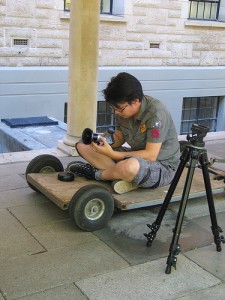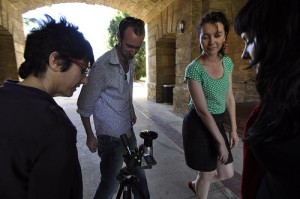You could think of live action fulldome cinema as being like the current fashion for 3D cinema: while 3D may be novel or exciting for an audience, not every film needs to be in 3D, and 3D doesn’t make everything automatically better.

Photographer: Eva Sprenkelder
However, because the dome is an immersive environment, cinematographers attempting a film for the dome need to address and explore some new thought processes in regards to traditional film making.
Which brings us to the question: To Dome or Not To Dome? Understanding what goes into creating a dome-specific film was explored in DomeLab 2010, which offered its participants an exciting opportunity to re-define cinematography and rethink the standard shooting practises for filming in this medium.
Shooting film for the dome means the camera – and thus the viewer – moves from voyeur to participant; you’re capturing footage from the point of ‘being there’ rather than looking on’. The filmmaker has far greater control of the audience’s physicality within their new environment, so that environment needs to be chosen accordingly. Specific environments where light and objects can control framing – such as vast plains, cathedrals, caves and forests – have immediate dome potential. These environments give that ‘awe factor’ that the dome creates for audiences above other mediums.
However, when you’re surrounded by an image it takes time for the brain to absorb that amount of information. Controlling where the audience looks within such a big area – and therefore directing the narrative – becomes the challenge. Too many cuts and camera angles will just make audience confused, disoriented and quite possibly sick. Shots need to be stripped and slowed down, and the audience’s attention is visually directed around the dome to follow the narrative. In this sense, Fulldome cinema is merging film with theatre, unravelling a scene within the shot rather than relying on a cutaway or a new angle.

Photographer: Eva Sprenkelder
Because of this, camera movement and placements where light and objects can control framing will take over from typical filmic shots such as close ups and over-the-shoulder shots. But who would have thought simplifying a shot list would make things so complicated? The choreography and length of what happens within a shot needs to be mapped out, and mise-en-scene of a shot is even more important.
Because the camera angle in Full dome is an all-encompassing 180 degrees, with the shot covering pretty much everything, you need to put a lot of thought into placing the camera department and hiding the jib and dolly tracks. The exciting part of doing this is creatively setting up the shot or finding a really good engineer to build something specific. Source light is your friend – using sunlight, lamps and street lights saves you having to hide hardware out of shot, such as film lights like Red Heads or Blondies.
It seems that when developing a blueprint for cinematographers for the Dome, the more discussion and experimentation, the better. But from the little experimentation we’ve had within the dome lab, I do believe with careful consideration of the dome environment a narrative piece that is commercially viable is possible, and done well, could be an amazing experience and a new boundary to push in the film making industry.
Claire Leach
Since completing her Bachelor of Arts in Media in 2004, Claire has filmed projects all over the world and teaches filmmaking to children in remote communities. Interested in pushing the boundaries of media, she has been involved with an immersive dome platform educational project for children to learn about our indigenous cultural history.
 This work is licensed under a Creative Commons Attribution-NonCommercial-ShareAlike 3.0 Unported.
This work is licensed under a Creative Commons Attribution-NonCommercial-ShareAlike 3.0 Unported.






